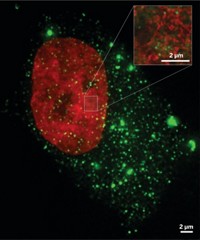Advertisement
Grab your lab coat. Let's get started
Welcome!
Welcome!
Create an account below to get 6 C&EN articles per month, receive newsletters and more - all free.
It seems this is your first time logging in online. Please enter the following information to continue.
As an ACS member you automatically get access to this site. All we need is few more details to create your reading experience.
Not you? Sign in with a different account.
Not you? Sign in with a different account.
ERROR 1
ERROR 1
ERROR 2
ERROR 2
ERROR 2
ERROR 2
ERROR 2
Password and Confirm password must match.
If you have an ACS member number, please enter it here so we can link this account to your membership. (optional)
ERROR 2
ACS values your privacy. By submitting your information, you are gaining access to C&EN and subscribing to our weekly newsletter. We use the information you provide to make your reading experience better, and we will never sell your data to third party members.
Biotechnology
Carbon nanotubes deliver DNA into plant cells
Two new methods relying on the nanomaterial may simplify genetic modification
by Kerri Jansen
February 28, 2019
| A version of this story appeared in
Volume 97, Issue 9
Carbon nanotubes, typically celebrated for their electrical properties and strength, may find a new and unexpected use in agriculture. This week, two research groups report that the nanomaterials can ferry DNA into plant cells, potentially making easy work of genetic engineering.
Plant biologists are looking for alternative ways to deliver genes. Slow-growing agrobacterium can be used to introduce genes, but only into certain plants. Or researchers can use a high-pressure “gene gun” to blast material into cells, sometimes damaging them in the process.
University of California, Berkeley, chemist Markita Landry and colleagues turned to carbon nanotubes. They took advantage of electrostatics to get DNA to stick to the nanomaterials. They coated the tubes with positively charged polyethylenimine, which attracts negatively charged DNA. As a proof of concept, they decorated nanotubes with DNA that codes for a green fluorescent protein, then used a needle-free syringe to deposit them in the leaves of arugula, cotton, wheat plants, and a relative of tobacco. The nanotubes penetrated the plant’s cell walls along with their DNA cargo, allowing the fluorescent protein to be expressed inside the leaves (Nat. Nanotechnol. 2019, DOI: 10.1038/s41565-019-0382-5).
Chemist Michael S. Strano of the Massachusetts Institute of Technology and colleagues targeted the chloroplast, the structure within the cell where photosynthesis occurs. DNA alterations in that part of the cell will only be passed through a plant’s maternal line—they won’t end up in pollen, so the risk of spreading them to other plants is minimized. But getting a particle into the chloroplast is challenging: It’s surrounded by two lipid bilayer membranes. Highly-charged particles can disrupt and pass partly through, but they pick up a coating of lipids, dulling their charge and halting their passage. The trick is producing a particle with enough charge to go the distance.
“If the particle has enough juice, it can cross all of those layers,” Strano says.
The researchers wrapped their carbon nanotubes with chitosan, a highly positively charged biopolymer, and then added DNA that expresses a yellow fluorescent protein. They infused the DNA-loaded nanotubes into the leaves of arugula, watercress, spinach, and tobacco (Nat. Nanotechnol. 2019, DOI: 10.1038/s41565-019-0375-4).
Both researchers see potential for carbon nanotubes to efficiently deliver genetic material to a broad array of plant species, unlike the choosy agrobacterium. And both groups are working to extend the carbon nanotube delivery method to carry other biological cargo, such as CRISPR-Cas9 or other gene editing tools.
“That would be the next big step,” says Zachary Lippman, a plant gene researcher at Cold Spring Harbor Laboratory. “The real goal is to get heritable transmission of edited DNA.”





Join the conversation
Contact the reporter
Submit a Letter to the Editor for publication
Engage with us on Twitter